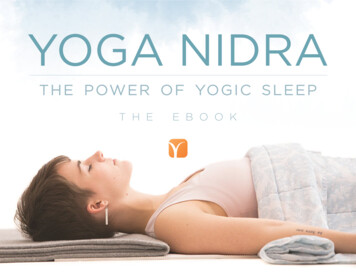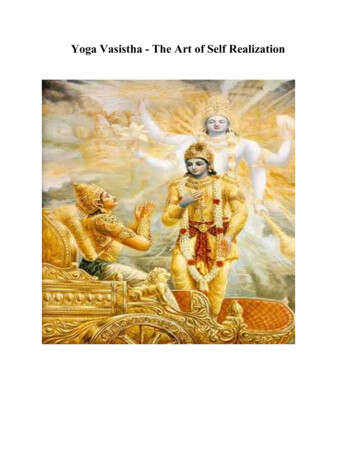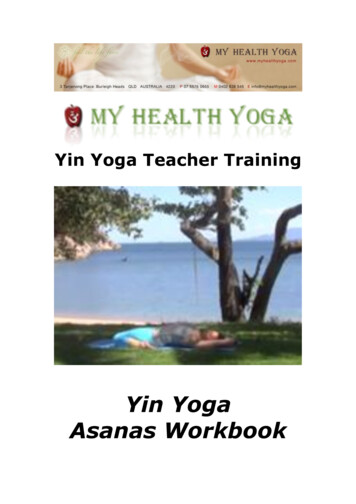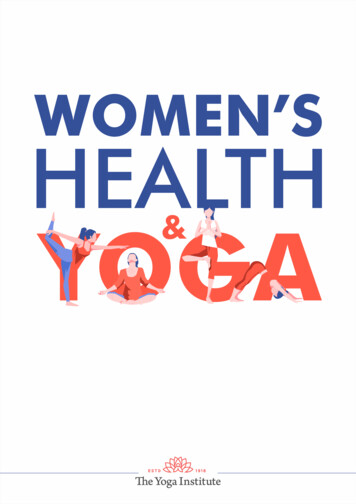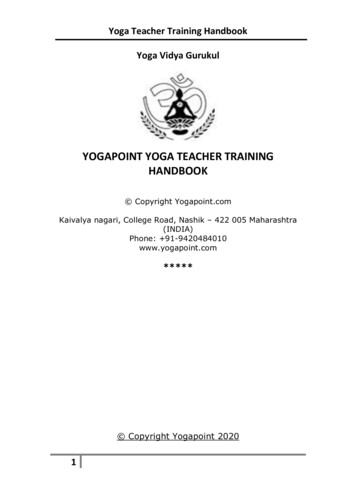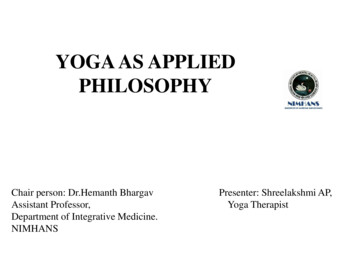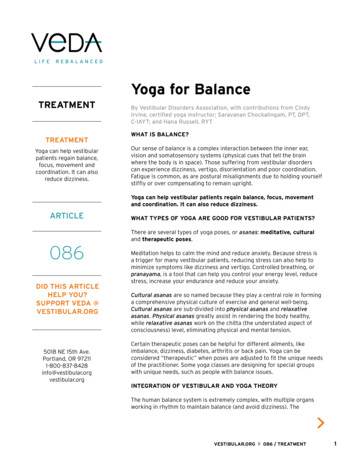
Transcription
Yoga for BalanceTREATMENTTREATMENTYoga can help vestibularpatients regain balance,focus, movement andcoordination. It can alsoreduce dizziness.By Vestibular Disorders Association, with contributions from CindyIrvine, certified yoga instructor; Saravanan Chockalingam, PT, DPT,C-IAYT; and Hana Russell, RYTWHAT IS BALANCE?Our sense of balance is a complex interaction between the inner ear,vision and somatosensory systems (physical cues that tell the brainwhere the body is in space). Those suffering from vestibular disorderscan experience dizziness, vertigo, disorientation and poor coordination.Fatigue is common, as are postural misalignments due to holding yourselfstiffly or over compensating to remain upright.Yoga can help vestibular patients regain balance, focus, movementand coordination. It can also reduce dizziness.ARTICLEWHAT TYPES OF YOGA ARE GOOD FOR VESTIBULAR PATIENTS?There are several types of yoga poses, or asanas: meditative, culturaland therapeutic poses.086DID THIS ARTICLEHELP YOU?SUPPORT VEDA @VESTIBULAR.ORG5018 NE 15th Ave.Portland, OR rgMeditation helps to calm the mind and reduce anxiety. Because stress isa trigger for many vestibular patients, reducing stress can also help tominimize symptoms like dizziness and vertigo. Controlled breathing, orpranayama, is a tool that can help you control your energy level, reducestress, increase your endurance and reduce your anxiety.Cultural asanas are so named because they play a central role in forminga comprehensive physical culture of exercise and general well-being.Cultural asanas are sub-divided into physical asanas and relaxativeasanas. Physical asanas greatly assist in rendering the body healthy,while relaxative asanas work on the chitta (the understated aspect ofconsciousness) level, eliminating physical and mental tension.Certain therapeutic poses can be helpful for different ailments, likeimbalance, dizziness, diabetes, arthritis or back pain. Yoga can beconsidered “therapeutic” when poses are adjusted to fit the unique needsof the practitioner. Some yoga classes are designing for special groupswith unique needs, such as people with balance issues.INTEGRATION OF VESTIBULAR AND YOGA THEORYThe human balance system is extremely complex, with multiple organsworking in rhythm to maintain balance (and avoid dizziness). TheVESTIBULAR.ORG :: 086 / TREATMENT1
vestibular system – the balance system in theinner ear – must coordinate with the brain and therest of the body. Three aspects of the vestibularsystem help with balance: vestibular ocular reflex(VOR), vestibular spinal reflex (VSR) and balancestrategies.1.VOR is a reflex that maintains visual focuswhen the head is moving in a different directionand/or at a different speed than the body. Whenpracticing yoga poses, focusing on a focal pointwhile moving the head and body in a differentdirection helps to foster the VOR reflex.2. VSR helps to maintain the body’s alignment,as well as the head’s position in relation tothe body. It also stabilizes the head duringmovement of the body. Practicing yoga“balance poses” helps to foster this VSR reflex,especially when you practice the poses witheyes closed.3.There are 3 strategies needed to maintainbalance. Ankle strategy – Activated in the ankle jointto maintain your center of mass Hip strategy – Activated when your centerof mass moves the hip joint forward andbackward Stepping strategy – Activated when yourcenter of mass moves away from your bodyTIPS FOR VESTIBULAR PATIENTS Practice against a wall: Patients withbalance issues should work near a wall toavoid falls, or have a chair as a balance aid;the back of the chair can be held like a balletbar. Breath: Focus on breathing slowly.Consciously relax the muscles in your neck,jaw, chest and diaphragm. This will also helpreduce anxiety. Feet: Balance can be enhanced by workingwith the feet, e.g., using toe separators, goingbarefoot as often as possible to keep themuscles of the feet strong and flexible, andgetting foot massages to keep awareness alivein the feet. Be gentle: Have compassion for your body.Healing is always slower than desired, andpushing too much goes against the yogicbelief that we are already perfect.2VESTIBULAR.ORG :: 086 / TREATMENTStart where you are. Pay attention. Try hard.Accept the limitations of your embodiment. Thisis the practice of yoga.TYPES OF YOGA POSES FOR BALANCE(See Appedix for images of each pose.) Forward bending – padahastasana Half waist bending – ardhakati chakrasana Backward bending – ardha chakrasana Triangle pose – trikonasana Revolved triangle pose – parivrtta trikonasana Side angle pose – parsvakonasana Warrior pose – virabhadrasana Tree pose – vrikshasana (advanced pose)TYPES OF PRANAYAMA (BREATHING) TOREDUCE ANXIETY AND STRESS Alternate nostril breathing (nadisudhi) – 5rounds Sectional breathing: Abdominal, intercostal,clavicular breathing – 5 rounds each Full Yogic breathing: Total lung breathing – 5rounds Female bee breath (bhramari) – 5 roundsIn addition to balance yoga poses, the followingposes are beneficial for strengthening andrelaxation. Some of these are advanced yoga poses,and it is recommended you practice them under theguidance of an experienced yoga instructor. Consultyour health care professional before starting a newexercise practice.GROUNDING POSES Mountain pose (tadasana) Corpse pose (savasana) Auspicious pose (svastikasana) Kneeling meditation pose – with or withoutsupport block (seiza or vajrasana)CHEST OPENERS (to help patients lift their spiritsand correct their posture): Bridge pose – taught with support (setu bandhsarvangasana) Camel pose – hands to sacrum & toes underfor increased stability (ustrasana) Locus pose – head above heart (salabhasana)
Lying down big toe pose (suptapadangusthasana)POSES TO LET THE EYES AND NERVOUSSYSTEM TAKE A BREAK The rising sun pose (surya namaskar) Half pigeon, one-legged or double-leggedpigeon pose (kapotasana) The reclined bound angle (supta baddhakonasana) Supported bridge – block at sacrum (setubandh saryangasana) Saddle pose (supta virasana) Toes pose with toes tucked (vajrasana/seiza) Child’s pose – wide-legged or narrow knee(balasana)MUSCLE STRETCHING POSES Head of the cow (gomukhasana) Staff pose (dandasana) 2018 Vestibular Disorders AssociationVeDA’s publications are protected under copyright.For more information, see our permissions guide atvestibular.org. This document is not intended as asubstitute for professional health care. Seated angle pose (upavista konasana)APPENDIXFORWARD BENDING - PADAHASTASANAHALF-WAIST BENDING - ARKHAKATICHAKRASANAVESTIBULAR.ORG :: 086 / TREATMENT3
BACKWARD BENDING - ARDHACHAKRASANASIDE ANGLE POSE - PARSVAKONASANA4VESTIBULAR.ORG :: 086 / TREATMENTTRIANGLE POSE - TRIKONASANAWARRIOR POSE - VIRABHADRASANA
SEATED ANGLE POSE - UPAVISTA KONASANAMOUNTAIN POSE - TADASANASTAFF POSE - DANDASANAAUSPICIOUS POSE - SVASTIKASANAVESTIBULAR.ORG :: 086 / TREATMENT5
6KNEELING MEDITATION POSE - SEIZA ORVAJRASANABRIDGE POSE - SETU BANDH SARVANGASANACAMEL POSE - USTRASANALOCUS POSE - SALABHASANAVESTIBULAR.ORG :: 086 / TREATMENT
RECLINED BOUND ANGLE POSE - SUPTA BADDHAKONASANATOES POSE - VAJRASANA/SEIZASUPPORTED BRIDGE - DANDASANAHEAD OF THE COW - GOMUKHASANAVESTIBULAR.ORG :: 086 / TREATMENT7
8CHILDS POSE - BALASANASADDLE POSE - SUPTA VIRASANALYING DOWN BIG TOE POSE - SUPTA PADANGUSTHASANATREE POSE - VRIKSHASANAVESTIBULAR.ORG :: 086 / TREATMENT
CORPSE POSE - SAVASANAHALF PIGEON POSE - KAPOTASANAVESTIBULAR.ORG :: 086 / TREATMENT9
NOTES:VESTIBULAR DISORDERS ASSOCIATION5018 NE 15th Ave. Portland, OR rgDid this free publication from VeDA help you?You can ensure that educational articles like this continue to be available to vestibular patients like you bymaking a tax-deductible gift to VeDA today.SUPPORT VEDAOne-time gift: 40 50 75 100 250otherMonthly gift: 10 15 25 35 50otherCheck this box if you prefer that your donation remain anonymous.PAYMENT INFORMATIONDonations gladly accepted online at http://vestibular.org. Check or money order in US funds, payable to VeDA.Visa MC Amex DiscoverCard numberExp. dateCVV codeBilling address of card (if different from mailing information)MAILING INFORMATIONName Telephone EmailAddress City State/Province ZipCountry[ UPDATED 2014 ]VESTIBULAR.ORG :: 086 / TREATMENT10
In addition to balance yoga poses, the following poses are beneficial for strengthening and relaxation. Some of these are advanced yoga poses, and it is recommended you practice them under the guidance of an experienced yoga instructor. Consult your health care professional


